The global eye shadow stick market is projected to grow from USD 21.65 Billion in 2025 to USD 36.07 Billion by 2035, reflecting a compound annual growth rate (CAGR) of 5.4%. This growth is driven by increasing consumer demand for convenient, long-lasting, and travel-friendly makeup solutions.
Eye shadow sticks offer a mess-free application, portability, and versatility, making them particularly appealing to busy professionals and on-the-go consumers. As beauty routines become more streamlined, the preference for such products is expected to rise, contributing to the market's expansion.
Technological advancements in product formulations are further fueling market growth. Manufacturers are focusing on creating eye shadow sticks with enhanced pigmentation, longer wear times, and improved skin compatibility.
The incorporation of nourishing ingredients like vitamin E and hydrating oils not only enhances the product's performance but also appeals to health-conscious consumers seeking multifunctional beauty solutions. These innovations are making eye shadow sticks more appealing to a broader audience, thereby driving market demand.
E-commerce platforms have become a significant distribution channel for eye shadow sticks, providing consumers with easy access to a wide range of products. The convenience of online shopping, coupled with the rise of beauty influencers and social media marketing, has increased consumer awareness and interest in these products.
Online retailers offer detailed product information, reviews, and tutorials, helping consumers make informed purchasing decisions and further boosting market growth.
Dior Beauty has launched its latest innovation-the Diorshow Cooling Stick, a waterproof eyeshadow stick infused with 40% water for an instant cooling effect and radiant finish. Available in Bronze Wave, Gold Splash, and Fresh Pink, the creamy formula delivers long-lasting, smudge-proof wear.
This launch follows the buzz around Dior’s Backstage Rosy Glow Stick, signaling a strong push into multi-use stick formats for summer 2025. The collection is now available across Dior counters and online platforms.
As consumer preferences continue to evolve towards convenience and efficiency, the eye shadow stick market is poised for sustained growth through 2035.
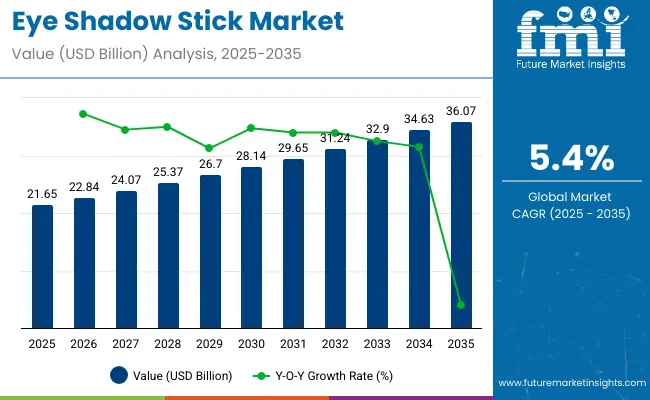
| Attribute | Detail |
|---|---|
| Market Size (2025) | USD 21.65 billion |
| Market Size (2035) | USD 36.07 billion |
| CAGR (2025-2035) | 5.4% |
Per capita spending on eye shadow sticks remains relatively modest due to their niche position within the broader eye makeup market. However, growing trends in personal grooming, social media influence, and product innovation are gradually increasing consumer expenditure in this segment globally.
The global trade of eye shadow sticks is driven by rising demand for convenient, easy-to-apply makeup products in both developed and emerging markets. Growth in online retail and beauty specialty stores has facilitated wider distribution and increased cross-border trade.
Cream eye shadow sticks will dominate the market with a 47.6% share in 2025, driven by their smooth application and blendability. Online sales channels will capture 55% of the market share, fueled by the increasing trend of online beauty shopping.
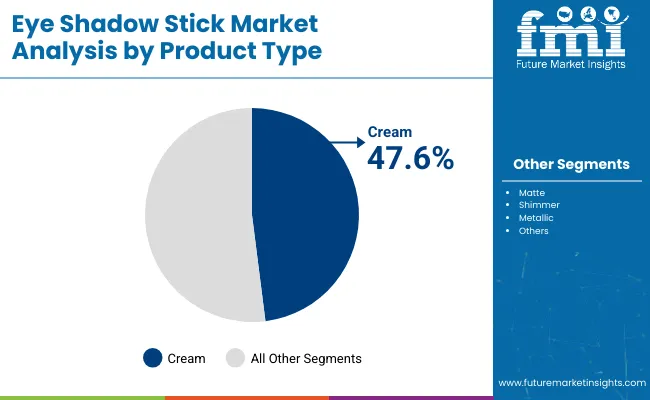
Cream eye shadow sticks are projected to hold a dominant 47.6% market share by 2025. Their smooth texture and ease of blending, coupled with long-lasting results, make them highly desirable for consumers seeking quick and flawless makeup applications.
With major beauty brands like Maybelline, L'Oréal, and Fenty Beauty offering a variety of shades, cream eye shadow sticks are popular in the beauty industry. They are ideal for both casual wear and special occasions, providing versatile and mess-free makeup solutions. The ongoing demand for convenience and high-quality products ensures cream eye shadow sticks remain at the forefront of the market.
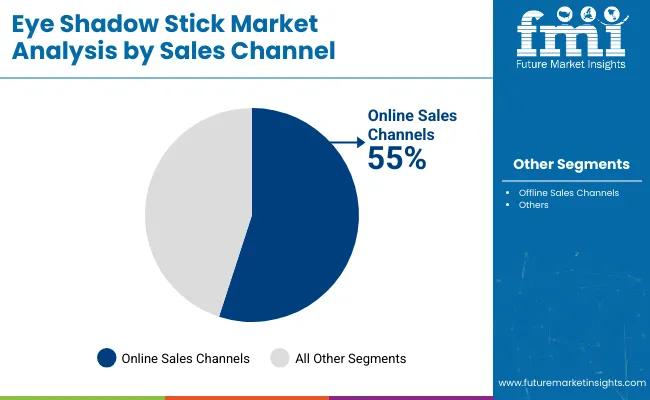
Online sales channels are projected to capture 55% of the eye shadow stick market by 2025. E-commerce platforms like Amazon, Sephora, and Ulta have made shopping for beauty products more accessible, enabling consumers to browse and purchase from the comfort of their homes.
With the rise of personalized recommendations, customer reviews, and easy price comparison, online shopping for eye shadow sticks is growing rapidly. Brands are increasingly focusing on digital platforms, offering exclusive discounts, home delivery, and special promotions to enhance the shopping experience. This shift to digital beauty retail is expected to drive significant growth in the eye shadow stick market.
There has been an increasing preference for premium, high-quality beauty products owing to skin awareness and the rising disposable income of the middle-class population.
Moreover, consumers who are makeup enthusiasts may want an eye shadow product that does not take a lot of time to apply. Hence, the demand for eye shadow sticks is increasing as these products provide a lot of colour with minimal effort in an easy, one-swipe application.
Beauty bloggers and the increasing penetration of social media are spreading awareness of the use and benefits of eye shadow sticks, which is expected to popularize these products. Furthermore, matte and shimmer are two different finishes of eye shadow sticks that are available in the market, that provide different eye shadow looks. These are major drivers that are estimated to drive the market growth during the forecast period.
Another major aspect of eye shadow sticks is that it is beginner friendly. Both amateurs and professional makeup artists can use this product with ease. In addition, the sales of eye shadow sticks are likely to flourish as these products are extremely versatile and can be used as an eyeliner, eyeshadow or by mixing the two as they blend easily with just a finger stroke.
Consumers further have the options of several colours and formulas such as non-waterproof, waterproof, and water-resistant when purchasing eye shadow sticks. These products are also available in 24-hour long-lasting formulas which do not crease, bleed or flake. Moreover, the e-commerce sector is fruitful for the eye shadow stick market share, as cosmetic product sales are the highest in the online sales platform.
Strict regulatory frameworks on adopting particular pigments in the cosmetics industry enforced by the Food and Drug Administration (FDA) are likely to impede market growth. Moreover, there may be side effects such as allergy, conjunctivitis, etc., that can arise in people with sensitive skin from using eye shadow sticks due to certain chemical ingredients, which is a major restraint for the eye shadow stick market.
Although natural and organic or clean beauty products are gaining popularity worldwide, they have a lower shelf-life compared to conventional eyeshadows, due to the absence of preservatives in the product. This factor, along with the fluctuating prices of cosmetic products, is likely to limit the global eye shadow stick market growth.
Conversely, manufacturers of luxury brands are attempting to develop eye shadow sticks in different sizes, so that the middle-class population can experiment with high-end cosmetic products without having to splurge. Additionally, to attract the younger generation, several key players are focusing on digital engagement through multimedia. These are future scopes of the market, which are anticipated to increase the product demand.
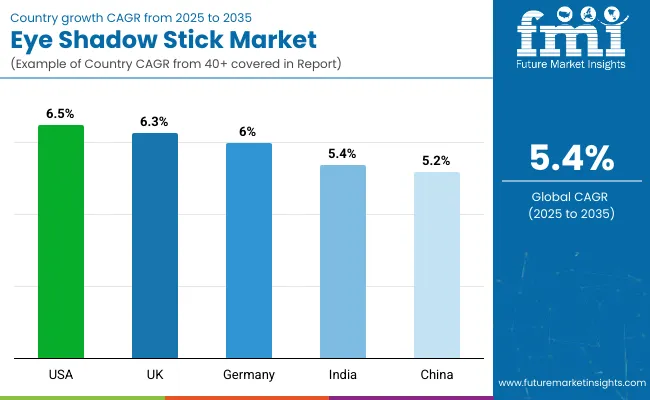
The North American market is estimated to account for 23.6% market share in terms of value in the global market, with the USA expected to account for over 78.1% of the North American market in 2024. Sales of eye shadow sticks are experiencing an uptick in the market owing to the rising penetration and promotion of beauty bloggers and makeup experts in the region.
Social media beauty influencers are playing an important role in changing the face of the skincare and cosmetics industry by attracting a significant number of beauty enthusiasts and followers on social media platforms such as Instagram, YouTube, and others.
Hence, influencer marketing, as a promotional strategy is gaining immense popularity among the leading beauty brands who are targeting potential beauty enthusiasts, i.e. a beauty consumer.
Many of the beauty bloggers and influencers based in the USA are engaged in creating beauty instruction videos and content where they also promote brands. Hence, they play an important role as mediators in influencing consumers' preferences regarding potential brands.Consequently, all these efforts undertaken by beauty social media influencers are likely to provide the brands with a competitive edge in the USA over the coming years.
The UK is projected to dominate Europe’s eye shadow stick market, exhibiting stellar growth at 4.9% CAGR over the forecast period. Recent clean beauty, natural, and organic skincare trends are bringing significant changes in the regional eye shadow stick market.
Leading players are now significantly engaged in extending their offerings to include organic eye shadow sticks. Few of these offerings are being promoted as organic eye shadows that are coloured by pure minerals obtained from nature.
Players operating in the regional market are using numerous claims and connotations such as natural, organic, vegan, and cruelty-free to further entice consumers. With the growing demand for organic eye shadow sticks, prominent brands are extending their organic range to include metallic party shades.
In 2024, India will account for over 33.8% market share in South Asia. Growth in the Indian market is further expected to be driven by the rising awareness and consciousness about skincare among consumers in the country. The significance of beauty has been rapidly increasing across India over the past few years.
Riding a wave of dynamic change, the beauty industry in India is currently more focused on fulfilling the needs of informed beauty consumers. Millennials in India are now more aware and informed about the products they purchase and use.
Premium brands and cosmetic ingredients with rapid results are instantly grabbing the major attention of consumers in India. Hence, their inclination towards safe and protective cosmetic products is likely to impact and facilitate change in trends in India’s eye shadow stick market. Besides this, with a growing number of informed beauty consumers in the country, demand has surged for eye shadow sticks with sustainable packaging, thus, improving the trend across India.
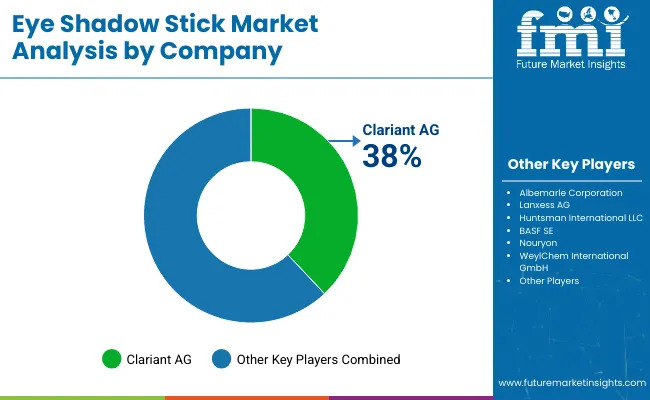
Eye shadow sticks are highly convenient for busy individuals, and the rising trend of using cosmetics to enhance one’s features is providing creative opportunities for both key manufacturers and start-up companies to introduce innovative formulas and products in the global eye shadow stick market.
| Report Attributes | Details |
|---|---|
| Market Size (2025) | USD 21.65 billion |
| Projected Market Size (2035) | USD 36.07 billion |
| CAGR (2025 to 2035) | 5.4% |
| Base Year for Estimation | 2024 |
| Historical Period | 2020 to 2024 |
| Projections Period | 2025 to 2035 |
| Quantitative Units | USD billion for value |
| Product Types Analyzed | Matte, Shimmer, Metallic, Cream |
| End Users Analyzed | Professional Makeup Artists, Individual Consumers |
| Mechanisms Analyzed | Retractable, Push-up, Wooden Pencil with Sharpener |
| Sales Channels Analyzed | Online Sales Channels (E-commerce Platforms, Brand-specific Online Stores, Social Media Marketplaces, Subscription Services), Offline Sales Channels (Supermarkets and Hypermarkets, Specialty Stores, Department Stores, Drugstores and Pharmacies, Beauty Salons and Spas, Duty-Free Shops, Standalone Brand Stores) |
| Regions Covered | North America, Latin America, Europe, East Asia, South Asia, Oceania, Middle East & Africa |
| Countries Covered | United States, Canada, Brazil, Mexico, Germany, France, United Kingdom, China, India, Japan, Australia, UAE, South Africa |
| Key Players Influencing the Market | Charlotte Tilbury, Pixi Beauty, Bobbi Brown, Kay Beauty by Katrina, M.A.C Cosmetics, Chanel, Dior Beauty, Givenchy, L'Oréal S.A., The Estée Lauder Companies Inc., Lancôme, Mamaearth, TOM FORD S.A., MAYBELLINE New York, Yves Saint Laurent, NYX Professional Makeup, Shiseido Company, Sephora, Rimmel London, Laura Mercier, Julep Beauty |
| Additional Attributes | Dollar sales growth by product type (matte, shimmer), application demand (professional, individual consumers), regional demand trends, competitive landscape, pricing strategies, consumer preferences, sales channel shifts, online vs offline performance |
The global eye shadow stick market is estimated to reach a valuation of USD 21.65 billion in 2025.
The global eye shadow stick market will grow at a ~5.4% CAGR between 2025 and 2035.
Leading players operating in the global eye shadow stick market are Charlotte Tilbury, Pixi Beauty, Bobbi Brown, Kay Beauty by Katrina, M.A.C Cosmetics, Chanel, Dior Beauty, Givenchy, L'Oréal S.A., The Estée Lauder Companies Inc., Lancôme, Mamaearth, TOM FORD S.A., MAYBELLINE New York, Yves Saint Laurent, NYX Professional Makeup, Shiseido Company, Sephora, Rimmel London, Laura Mercier, and Julep Beauty among others.
The global eye shadow stick market grew at a CAGR of ~4.6% from 2020 to 2024.






Our Research Products

The "Full Research Suite" delivers actionable market intel, deep dives on markets or technologies, so clients act faster, cut risk, and unlock growth.

The Leaderboard benchmarks and ranks top vendors, classifying them as Established Leaders, Leading Challengers, or Disruptors & Challengers.

Locates where complements amplify value and substitutes erode it, forecasting net impact by horizon

We deliver granular, decision-grade intel: market sizing, 5-year forecasts, pricing, adoption, usage, revenue, and operational KPIs—plus competitor tracking, regulation, and value chains—across 60 countries broadly.

Spot the shifts before they hit your P&L. We track inflection points, adoption curves, pricing moves, and ecosystem plays to show where demand is heading, why it is changing, and what to do next across high-growth markets and disruptive tech

Real-time reads of user behavior. We track shifting priorities, perceptions of today’s and next-gen services, and provider experience, then pace how fast tech moves from trial to adoption, blending buyer, consumer, and channel inputs with social signals (#WhySwitch, #UX).

Partner with our analyst team to build a custom report designed around your business priorities. From analysing market trends to assessing competitors or crafting bespoke datasets, we tailor insights to your needs.
Supplier Intelligence
Discovery & Profiling
Capacity & Footprint
Performance & Risk
Compliance & Governance
Commercial Readiness
Who Supplies Whom
Scorecards & Shortlists
Playbooks & Docs
Category Intelligence
Definition & Scope
Demand & Use Cases
Cost Drivers
Market Structure
Supply Chain Map
Trade & Policy
Operating Norms
Deliverables
Buyer Intelligence
Account Basics
Spend & Scope
Procurement Model
Vendor Requirements
Terms & Policies
Entry Strategy
Pain Points & Triggers
Outputs
Pricing Analysis
Benchmarks
Trends
Should-Cost
Indexation
Landed Cost
Commercial Terms
Deliverables
Brand Analysis
Positioning & Value Prop
Share & Presence
Customer Evidence
Go-to-Market
Digital & Reputation
Compliance & Trust
KPIs & Gaps
Outputs
Full Research Suite comprises of:
Market outlook & trends analysis
Interviews & case studies
Strategic recommendations
Vendor profiles & capabilities analysis
5-year forecasts
8 regions and 60+ country-level data splits
Market segment data splits
12 months of continuous data updates
DELIVERED AS:
PDF EXCEL ONLINE
Key Companies & Market Share in the Eye Shadow Stick Sector
Canada Eyeshadow Stick & Blush Stick Market Size and Share Forecast Outlook 2025 to 2035
Eye Shadow Market Insights – Size, Trends & Forecast 2025 to 2035
Eyebrow Makeup Market Size and Share Forecast Outlook 2025 to 2035
Eye Tracking System Market Forecast and Outlook 2025 to 2035
Stick Packaging Market Size and Share Forecast Outlook 2025 to 2035
Eye Testing Equipment Market Size and Share Forecast Outlook 2025 to 2035
Eye Health Ingredients Market Size and Share Forecast Outlook 2025 to 2035
Eye Protection Equipment Market Size and Share Forecast Outlook 2025 to 2035
Eye Cosmetic Packaging Market Size and Share Forecast Outlook 2025 to 2035
Eye and Face Protection Market Growth - 2025 to 2035
Global Eye Infections Treatment Market Report - Trends & Forecast 2025 to 2035
Eyeliner and Kajal Sculpting Pencil Packaging Market Trends and Forecast 2025 to 2035
Eyelid Scrub Market Analysis & Forecast by Product, Application and Region 2025 to 2035
Eye Care Supplement Analysis by Ingredients, Dosage Form, Route of Administration, Indication, Distribution channel and Region 2025 to 2035
Eyewear Market Analysis by Product Type, End Use, Sales Channel, Material Type, and Region
Evaluating Eyeliner and Kajal Sculpting Pencil Packaging Market Share & Provider Insights
Competitive Overview of Eyewear Packaging Companies
Market Share Insights of Eye Cosmetic Packaging Providers
Market Share Breakdown of Stick Packaging Solutions

Thank you!
You will receive an email from our Business Development Manager. Please be sure to check your SPAM/JUNK folder too.
Chat With
MaRIA